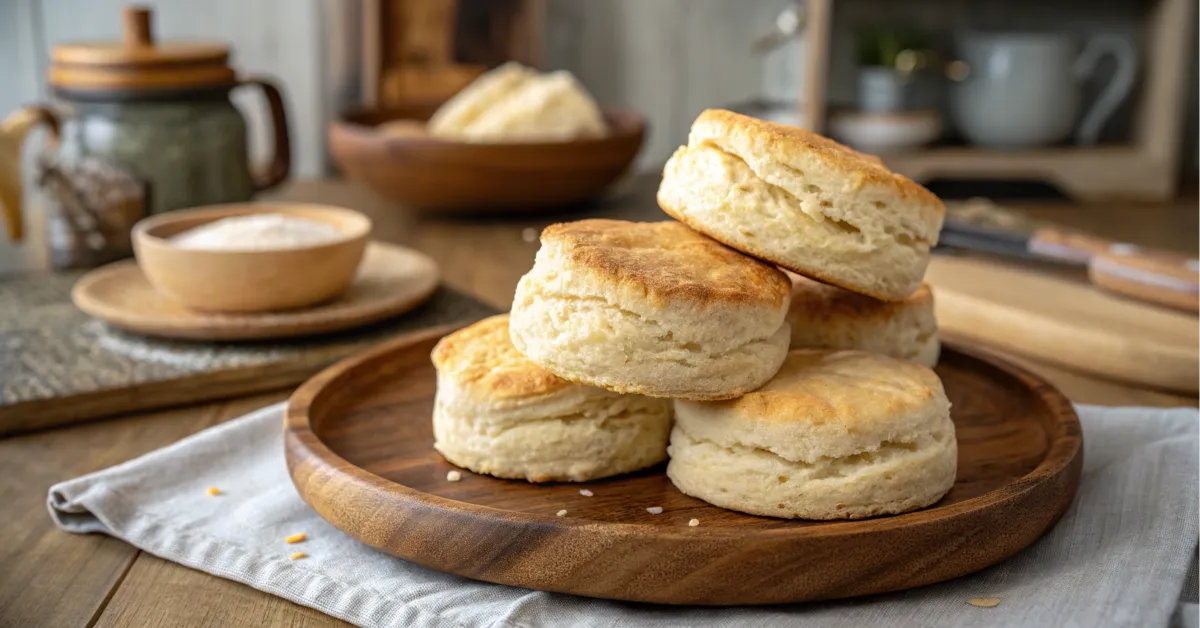Does Pillsbury make any gluten free biscuits? Gluten-free diets have significantly transformed the food industry in recent years. Many individuals avoid gluten because of celiac disease, gluten intolerance, or personal preference. For some, even trace amounts of gluten can cause severe health problems. Pillsbury, a trusted name in baking, remains popular for its convenient and delicious products. However, the big question is whether Pillsbury offers gluten-free biscuits. This guide answers that question while providing insights, alternatives, and a simple recipe for making gluten-free biscuits at home.
Table of contents
What Are Gluten-Free Biscuits and Why Are They Important?
Gluten-free biscuits are crucial for anyone avoiding gluten. Traditional biscuits rely on wheat flour, which contains gluten. Moreover, gluten provides dough with elasticity and aids in rising. However, for individuals with gluten sensitivities or celiac disease, consuming gluten can lead to serious health issues. Accordingly, gluten-free biscuits substitute wheat flour with alternatives such as almond flour, rice flour, or oat flour. These flours ensure safe and delicious biscuits for those with dietary restrictions.
Why Gluten-Free Matters
Celiac disease, an autoimmune disorder, affects about 1% of the population. For these individuals, even tiny traces of gluten can harm their intestines and cause long-term health risks. Additionally, others may experience non-celiac gluten sensitivity, with symptoms like bloating, headaches, or fatigue. Meanwhile, gluten-free options have gained popularity among those following low-carb or paleo diets. Therefore, having access to gluten-free biscuits allows everyone to enjoy comforting baked goods without compromising their health.
Flavors and Textures of Gluten-Free Biscuits
One challenge of gluten-free baking lies in achieving the right texture. Gluten-free flours behave differently from wheat flour. For example, almond flour produces biscuits with a nutty flavor, while rice flour creates light, airy biscuits. Meanwhile, coconut flour adds natural sweetness, making it ideal for breakfast biscuits. Therefore, combining various gluten-free flours often yields the best results, as each flour offers unique qualities.
For a full list of popular gluten-free biscuit brands, check out this guide on gluten-free biscuits.
Does Pillsbury Make Any Gluten Free Biscuits? Everything You Need to Know
Pillsbury boasts a long history of offering easy-to-make products. They are well-known for their pre-made dough, ready-to-bake cookies, and pie crusts. At one time, Pillsbury included gluten-free options, such as biscuit dough and pizza crusts. However, Pillsbury discontinued their gluten-free line, leaving many customers disappointed and searching for alternatives.
Why Did Pillsbury Discontinue Gluten-Free Biscuits?
Producing gluten-free products is challenging for large companies. Facilities need to be entirely free of gluten to avoid cross-contamination. This process requires extra steps, separate equipment, and higher costs. Pillsbury may have found it difficult to maintain these standards while meeting demand. Additionally, the market for gluten-free baked goods is smaller than for traditional products, making it less profitable for big brands.
Did You Know?
Many smaller brands now specialize in gluten-free products, offering a wider range of options than larger companies like Pillsbury. These brands are often better equipped to meet the needs of gluten-free consumers.
For another gluten-free option, read more about Yoyo Biscuits and their gluten-free alternatives.
Making Gluten-Free Biscuits at Home
If you can’t find gluten-free Pillsbury biscuits, don’t worry. Making them at home is simple, rewarding, and allows you to customize the recipe. Homemade biscuits often taste fresher and are healthier because you control the ingredients.
Ingredients for Gluten-Free Biscuits
The following recipe uses basic ingredients you can find at most grocery stores:
| Ingredient | Amount | Notes |
|---|---|---|
| Gluten-free flour | 2 cups | Almond, rice, or a certified gluten-free mix. |
| Baking powder | 1 tbsp | Ensure it is labeled gluten-free. |
| Salt | 1 tsp | Adjust based on your taste preferences. |
| Unsalted butter | 1/2 cup | Use vegan butter for a dairy-free version. |
| Milk (or substitute) | 1 cup | Almond, oat, or soy milk works well. |
Optional Ingredients for Flavor
- Cheese: Add shredded cheddar for savory biscuits.
- Honey: Mix in a tablespoon for a touch of sweetness.
- Herbs: Try chopped rosemary or parsley for a gourmet twist.

Step-by-Step Instructions
- Preheat Your Oven
Set your oven to 375°F. Line a baking sheet with parchment paper to prevent sticking. - Mix Dry Ingredients
Combine gluten-free flour, baking powder, and salt in a large bowl. Use a whisk to ensure the ingredients are evenly distributed. - Add Cold Butter
Cut cold butter into small cubes. Add it to the dry mixture and use a pastry cutter or your hands to blend it. The texture should resemble coarse crumbs. - Incorporate Milk
Slowly pour in milk or a dairy-free alternative. Stir gently until the mixture forms a dough. Avoid overmixing, as this can make the biscuits tough. - Shape the Dough
Lightly flour a surface and roll out the dough to about 1-inch thickness. Use a biscuit cutter or a round glass to cut out shapes. - Bake the Biscuits
Arrange the biscuits on the prepared baking sheet. Leave space between them for even baking. Bake for 12-15 minutes or until the tops turn golden brown. - Serve and Enjoy
Allow the biscuits to cool slightly before serving. They pair perfectly with butter, jam, or honey.
Tips for Success
- Choose the Right Flour Mix: Experiment with different gluten-free blends to find the texture you love.
- Keep Everything Cold: Cold butter and milk help create flakier biscuits.
- Don’t Overwork the Dough: Stir until just combined to avoid dense biscuits.
- Rest the Dough: Let it sit for 5-10 minutes before shaping. This allows the flour to fully hydrate, improving the texture.
- Add Variety: Try sweet or savory add-ins like cinnamon, cheese, or herbs.

Pro Tips & Variations for Gluten-Free Biscuits
Baking gluten-free biscuits is both an art and a science. Achieving the perfect texture and flavor requires some planning and patience. The following tips and variations will ensure your biscuits are light, fluffy, and packed with flavor. Whether you’re a beginner or an experienced baker, these suggestions will help you master the process.
Key Tips for Perfect Biscuits
- Use the Right Flour Blend
A balanced gluten-free flour mix is essential. Almond flour and rice flour work well together, but adding tapioca starch or potato starch can improve texture. To mimic the elasticity of gluten, include a small amount of xanthan gum. - Keep Ingredients Cold
Cold butter and milk are crucial for flaky biscuits. You can chill your mixing bowl and utensils before starting to keep the dough cool. - Mix Gently
Overmixing the dough can make biscuits dense. Combine the ingredients just until the dough comes together. - Rest the Dough
Let the dough rest for 10 minutes before shaping. This allows the flour to absorb moisture, creating a softer and more cohesive texture. - Adjust for Altitude
If you’re baking at high altitude, add a little more liquid and slightly reduce the baking powder to ensure your biscuits rise evenly.
Creative Variations
- Cheese Biscuits: Add shredded cheddar cheese and a pinch of garlic powder for a savory twist.
- Sweet Biscuits: Mix in a tablespoon of sugar and a splash of vanilla extract for a sweeter version.
- Herb-Infused Biscuits: Add fresh rosemary or thyme for a fragrant, gourmet flavor.
- Dairy-Free Option: Replace butter with coconut oil and milk with almond milk for a vegan-friendly recipe.

FAQs: Common Questions About Gluten-Free Biscuits
Many people wonder about gluten-free biscuits and Pillsbury’s offerings. Accordingly, here are answers to the most frequently asked questions, along with useful tips for gluten-free baking.
Do They Make Gluten-Free Pillsbury Biscuits?
No, Pillsbury no longer produces gluten-free biscuits. While they previously offered a gluten-free line, these products were discontinued due to production costs and limited demand.
Which Popular Biscuits Are Gluten-Free?
Many brands offer gluten-free biscuits, including King Arthur Baking and Schär. These products are widely available and provide excellent alternatives to Pillsbury.
Why Did Pillsbury Discontinue Gluten-Free?
Producing gluten-free items requires separate facilities to prevent cross-contamination. This process is expensive and likely made it difficult for Pillsbury to continue offering gluten-free options.
Does Pillsbury Make a Gluten-Free Crust?
Currently, Pillsbury does not offer gluten-free pie or pizza crusts. However, many other brands, such as Bob’s Red Mill, provide gluten-free crust options.
What Flours Work Best for Gluten-Free Biscuits?
Blends of almond flour, rice flour, and tapioca starch work ideally for gluten-free baking. Additionally, mixing different flours helps achieve the perfect balance of flavor and texture.
Can You Freeze Gluten-Free Biscuits?
Yes, gluten-free biscuits can be frozen. Once baked, let them cool completely, then store them in an airtight container. Reheat in the oven to bring back their original texture.
Are Gluten-Free Biscuits Healthy?
Gluten-free biscuits can be healthier if made with nutrient-rich flours like almond or coconut flour. However, they should still be eaten in moderation.

The Benefits of Kefir in Gluten-Free Baking
Kefir, a fermented milk product, serves as a game-changer for gluten-free recipes. It works as a natural leavening agent, helping biscuits rise while ensuring they remain soft and tender. Additionally, kefir adds a subtle tangy flavor that complements both sweet and savory variations.
Using kefir improves the consistency of your dough, making it easier to handle. Additionally, it is rich in probiotics, providing a nutritional boost to your biscuits.
Learn more about the benefits of kefir in baking with this in-depth guide.
Why Buckwheat Is a Great Gluten-Free Option
Buckwheat flour is a nutritious and flavorful choice for gluten-free baking. Despite its name, buckwheat is entirely gluten-free. Its hearty flavor and dense texture make it a popular choice for biscuits, especially when paired with savory toppings like gravy or butter.
In addition to being gluten-free, buckwheat is rich in nutrients, including fiber and protein. It also has a distinct nutty taste that adds depth to your recipes. Using a blend of buckwheat and almond flour can create biscuits that are both flavorful and satisfying.
Explore the many uses of buckwheat in this article on buckwheat pancake mix.

Conclusion: Enjoying Gluten-Free Baking
Gluten-free baking opens up a world of possibilities for creating delicious and satisfying biscuits. While Pillsbury no longer offers gluten-free options, plenty of alternatives from other brands and homemade recipes allow you to enjoy this comforting treat. By experimenting with ingredients like kefir and buckwheat, you can tailor your biscuits to match your taste and dietary preferences. With the helpful tips and variations in this guide, baking gluten-free biscuits becomes simpler and more enjoyable. For official information on gluten-free food labeling and regulations, visit Wikipedia’s guide on gluten-free regulations.


1 thought on “Does Pillsbury Make Gluten-Free Biscuits? A Complete Guide”